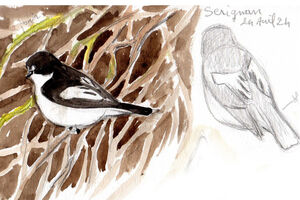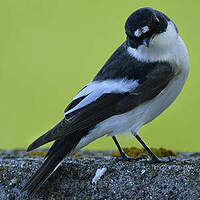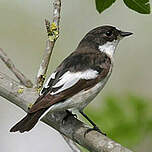European Pied Flycatcher
Ficedula hypoleuca - Gobemouche noir
Identification
The adult European Pied Flycatcher shows a clear sexual dimorphism. However this species can show variability in male plumage in different regions, ranging from the typical black and white plumage shared by other males of its genus, to a much less contrasted one which is rather similar to the female's. The female's plumage is invariable, featuring brown and white. The determination of a black and white European Pied Flycatcher male requires careful attention since 4 species of the genus have this type of male, 3 of them being European and 2 of them French. The male, in its nuptial black and white plumage, has black upperparts and white underparts; a white forehead patch and a large and elongated wing patch are quite visible on the black feathers. Its black tail is bordered with white at the base. Its dark eye is easily merged with its black environment. Its beak and legs are black. The palest male, e.g. the one nesting sympatrically with the Collared Flycatcher, has (lighter) grayish-brown upperparts and a smaller forehead patch which is sometimes divided in two. The post-nuptial male looks like a female but with more white on its wings. The female has brown upperparts with wings and tail darker, its underparts look like dull white slightly tinted with grayish-brown on the throat and chest. Its forehead is brown. The white wing patch is much less contrastive and discontinuous. The juvenile has a spotted look like many Muscicapid juveniles, due to the dark edging on its upper and lower patterns. The species can be identified by its white patches on its wings and tail. When migrating post-nuptially, after the moulting, all individuals tend to look more alike.
Subspecific information 3 subspecies
- Ficedula hypoleuca hypoleuca (w and n Europe to the Ural Mts.)
- Ficedula hypoleuca iberiae (Iberian Pen.)
- Ficedula hypoleuca sibirica (w and sc Siberia)
Foreign names
- Gobemouche noir,
- Papamoscas cerrojillo,
- papa-moscas-preto,
- Trauerschnäpper,
- kormos légykapó,
- Bonte Vliegenvanger,
- Balia nera,
- svartvit flugsnappare,
- Svarthvit fluesnapper,
- muchárik čiernohlavý,
- lejsek černohlavý,
- Broget Fluesnapper,
- kirjosieppo,
- mastegatatxes,
- Flekkugrípur,
- muchołówka żałobna,
- melnais mušķērājs,
- črnoglavi muhar,
- Мухоловка-пеструшка,
- マダラヒタキ,
- 斑姬鹟,
- svartvit flugsnappare,
- 斑姬鶲,
Voice song and call
The song of the European Pied Flycatcher is typically muscicapidé. It should be imagined coming from an old, leafy or mixed woodland. It is a short, stereotyped, but melodious and somewhat melancholic phrase. It is similar to the song of the White-fronted Redstart. It is repeated at regular intervals. It must be well remembered for an effective search of this species. The alarm call on the territory is a repeated pit or pjit. It makes one think of a distant call of the Blackbird. During migration, it can produce high-pitched cries srrii.
Habitat
For nesting, the European Pied Flycatcher searches for mature natural woodland that can provide it with favourable cavities.
Behaviour character trait
The European Pied Flycatcher is a territorial species whose male members do not tolerate the presence of members of the same sex in their territory.
On the other hand, these same mated territorial males are open to the idea of hosting a second female to optimize reproduction. In regions where two species of Ficedula coexist, it is of course necessary to make accommodations. For example, this is the case in the northeast of France. The European Pied Flycatcher occupies beech woods or mixed woodlands while the Collared Flycatcher is confined exclusively to oaks. Specific vocalizations contribute to this segregation, which prevents competition problems.Flight
The European Pied Flycatcher is a long distance migrant whose breeding and wintering grounds are disjoint. It therefore has the long wings of a migratory bird and its migratory flights are done at night. Its skill in flight is of course also useful in its daytime hunting of insects. It is capable of making short hovering flights to locate its prey.
Dietfeeding habits
The European Pied Flycatcher's flying abilities allow it to hunt for both flying preys and those resting on the ground or in vegetation at all heights in the forest.
Its diet obviously reflects this. For example, with Lepidoptera (i.e. butterflies), it can capture both imago in flight and larvae resting on the ground. Insects make up a large part of its diet, all sorts of course, but it also samples other arthropods, spiders, millipedes and small crustaceans. It can also consume small mollusks and earthworms. Finally, it sometimes eats plant items, particularly small berries when they are late in the season, such as wild currants or elderberries.Reproduction nesting
The arrival at the breeding sites takes place at the middle of April and continues into May, depending on the latitude and local conditions.
Males start singing upon their arrival and defend their chosen territory with their voice. As soon as a female appears, the male increases the activity of his vocals and gesture to make her adopt the cavity that he has chosen. Indeed, this species is a cave dweller, which is characteristic of the family. The cavity is usually in a tree at a variable height, from 2 to 10 meters mostly, but also depending on the case, in a rocky protrusion or an old wooden house wall. The species readily adopt provided birdhouses, which facilitates the scientific follow-up. The nest itself is made of dead leaves, dry grass, moss and lined with rootlets, or even animal fur, more rarely feathers. The clutch consists of 3 to 10 eggs, usually 4 to 8, of a pale blue colour, incubated solely by the female during 13 to 15 days. The hatchings are usually synchronous. The chicks are covered for a week by the female, and fed by the male. If the male has a second wife, as it happens, he neglects the first one, who is forced to struggle on her own. The stay of the young in the nest is 14 to 18 days. As soon as they leave the nest, the family usually leaves the territory. The young are still fed by the adults for a good week before they become autonomous and hunt on their own.Geographic range
The European Pied Flycatcher can be found in the breeding season from Scandinavia to the Mediterranean and Black Sea in the south, and from the Atlantic to close to Mongolia in Russia in the east. Thus, it is mostly a European bird. It is less frequent in the southern part of the continent. In France, it is predominant in the northeast. It spends its winters in Africa south of the Sahara, from Senegal to the north of the Democratic Republic of the Congo.
Threats - protection
IUCN conservation status
concern
in the Wild
threatened
evaluated
For now, the species is not threatened. However, the impending climate changes could affect it, either directly or indirectly through their impact on the forest and entomofauna.
Sources of information
- IOC World Bird List (v14.2), Gill, F and D Donsker (Eds). 2024-04-18.
- An Atlas of the Birds of the Western Palearctic, Colin Harrison
- Les Passereaux Vol. III des pouillots aux moineaux, Paul Géroudet
Other sources of interest
 Specification sheet created on
20/07/2023 by Jean François
Specification sheet created on
20/07/2023 by Jean FrançoisTranslation by AI Oiseaux.net
© 1996-2025 Oiseaux.net
- Accipitriformes
- Aegotheliformes
- Anseriformes
- Apodiformes
- Apterygiformes
- Bucerotiformes
- Caprimulgiformes
- Cariamiformes
- Casuariiformes
- Charadriiformes
- Ciconiiformes
- Coliiformes
- Columbiformes
- Coraciiformes
- Cuculiformes
- Eurypygiformes
- Falconiformes
- Galliformes
- Gaviiformes
- Gruiformes
- Leptosomiformes
- Mesitornithiformes
- Musophagiformes
- Nyctibiiformes
- Opisthocomiformes
- Otidiformes
- Passeriformes
- Pelecaniformes
- Phaethontiformes
- Phoenicopteriformes
- Piciformes
- Podargiformes
- Podicipediformes
- Procellariiformes
- Psittaciformes
- Pterocliformes
- Rheiformes
- Sphenisciformes
- Steatornithiformes
- Strigiformes
- Struthioniformes
- Suliformes
- Tinamiformes
- Trogoniformes


































